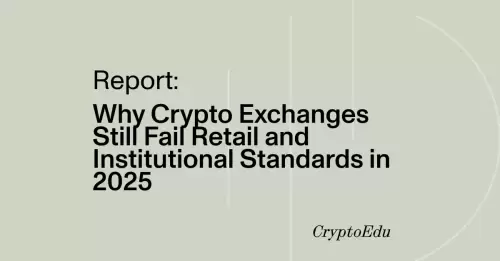 |
|
 |
|
 |
|
 |
|
 |
|
 |
|
 |
|
 |
|
 |
|
 |
|
 |
|
 |
|
 |
|
 |
|
 |
|
Articles d’actualité sur les crypto-monnaies
Pi Network Launches Its Open Mainnet, Opening Up the Network to the World
May 14, 2025 at 01:46 pm

Pi Network, the cryptocurrency that can be mined on mobile phones and has over 40 million members globally, is getting closer to launching its full Open Mainnet. This transition would see the network operating in a completely open capacity, allowing for broader exchange listings and seamless integration with other systems.
The project, co-founded by two Stanford PhDs, Dr. Nicolas Kokkalis and Dr. Chengdiao Fan on March 14, 2019, set out to create a cryptocurrency mining method accessible to everyone through their smartphone, in contrast to the specialized hardware usually required for crypto mining.
After launching its Enclosed Mainnet in December 2021, Pi Network has been working towards shifting from a closed system to an openly connected one. The Enclosed Mainnet saw the blockchain operating in a walled-off environment, allowing the team to concentrate on adding more users to the network through Know Your Customer (KYC) checks, transferring the mined Pi coins to the mainnet, and aiding in the development of applications and tools within its own ecosystem.
With completed KYC, users, called Pioneers, could use Pi Network’s applications and interact with each other within this limited space. However, this mainnet wasn’t yet able to link up with other blockchain networks, users couldn’t use external wallets, and Pi Coin wasn’t available on public crypto exchanges.
While members of the community and some reports had speculated that this transition might occur around February 20, 2025, or early in 2025, the main Pi Network team had consistently stated that their focus was on reaching specific goals first. These goals included substantial progress in KYC sign-ups, shifting the coins to the Mainnet, and having a strong lineup of apps on the network.
As of early May 2025, the big Open Mainnet launch was still on the horizon, with the team emphasizing that they would go live when they’re ready, not by a set date.
To prepare for the network’s complete opening, the project has a to-do list:
* More users need to pass KYC. This process is crucial for opening up the network fully and tying it to broader financial systems.
* The project aims to develop a comprehensive ecosystem of apps. Some interesting projects are already in the works, such as a stablecoin, a decentralized autonomous organization (DAO), and an application for managing personal identity on the blockchain, collectively decided upon by the community.
* The project is focused on launching an "open-source environment" to encourage more developers to build on Pi Network.
Pi Network stands out with its method of mobile phone mining, designed to be light on battery and accessible to anyone. In contrast to Bitcoin’s energy-intensive mining, which is done on specialized hardware, Pi Network users “mine” the coin by tapping a button in the app each day. This is meant to demonstrate their ongoing engagement with the network and contributes to building the overall trustworthiness of the system.
The network uses a variant of the Stellar Consensus Protocol (SCP) and Federated Byzantine Agreement (FBA) for reaching agreement on transactions, which relies on “security circles”—small groups of users who vouch for each other—to confirm transactions. This is said to be an efficient and planet-friendly method, contrasting with Proof-of-Work (PoW) or the commonly known Proof-of-State (PoS) systems.
There’s a hard cap of 100 billion Pi coins in total. Of this:
* 80% goes to the Community (that’s 80 billion Pi)
* Mining Rewards (65 billion Pi): This is for coins users have mined and will mine. A good chunk of Pi was mined before the Mainnet really got going, but the actual amount that gets moved over will depend on users passing KYC.
* Community and Ecosystem (10 billion Pi): A future Pi Foundation will look after this pot, using it for grants, community get-togethers, and helping the ecosystem grow.
* Liquidity Pool Reserves (5 billion Pi): This stash is to make sure there’s enough Pi flowing smoothly for trading and use within the system.
* 20% is for the Core Team (20 billion Pi): This share for the team gets released gradually, based on how much mining the community accomplishes.
The rate at which users can mine Pi is set to decrease as more people join, meant to make Pi a bit rarer over time and reward those who started mining earlier. Transaction fees on the Pi Network are said to be burned (destroyed), which would naturally reduce the total coin supply.
A huge part of Pi Network’s plan is to create an ecosystem packed with useful apps and services. People use the Pi Browser to explore these DApps (decentralized applications) and other Web3 offerings. Some cool project and app types include:
* A decentralized
Clause de non-responsabilité:info@kdj.com
Les informations fournies ne constituent pas des conseils commerciaux. kdj.com n’assume aucune responsabilité pour les investissements effectués sur la base des informations fournies dans cet article. Les crypto-monnaies sont très volatiles et il est fortement recommandé d’investir avec prudence après une recherche approfondie!
Si vous pensez que le contenu utilisé sur ce site Web porte atteinte à vos droits d’auteur, veuillez nous contacter immédiatement (info@kdj.com) et nous le supprimerons dans les plus brefs délais.
-

-

-

-

-

- Les perpétuaux décentralisés planent: le volume atteint un haut de tous les temps, laissant les CEX dans la poussière?
- Aug 05, 2025 at 03:38 pm
- Les futurs perpétuels décentralisés sont en plein essor! Juillet a vu un volume de trading record, dirigé par Hyperliquide. Cette poussée de Defi peut-elle remettre en question les échanges centralisés?
-

- Décodage MYCUSD: Prévision de la crypto pour le succès des actifs numériques
- Aug 05, 2025 at 03:37 pm
- Naviguez dans le paysage de la cryptographie MYCUSD avec des prévisions efficaces. Comprendre la dynamique du marché, les facteurs clés et les stratégies d'investissement éclairé dans les actifs numériques.
-

- Crypto, CEFI et Trust Gaps: Navigation de la frontière numérique en 2025
- Aug 05, 2025 at 03:34 pm
- En 2025, le paysage cryptographique fait face à des lacunes de confiance dans le CEFI, malgré des innovations comme l'intégration de la cryptographie de Paypal. L'équilibrage de l'innovation avec une protection des utilisateurs robuste reste la clé.
-

-

- CEINIOG COIN de James Howells: une histoire de retour de Bitcoin?
- Aug 05, 2025 at 03:26 pm
- James Howells, connu pour avoir perdu 8 000 Bitcoins, vise un retour crypto avec CEINIOG COIN, intégrant la blockchain de Bitcoin. Est-ce que cela réussira malgré les revers et les questions de financement passés?




























































